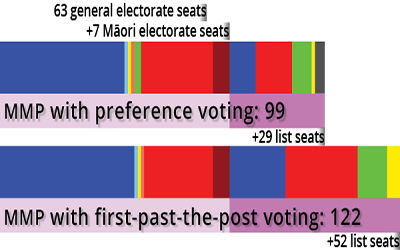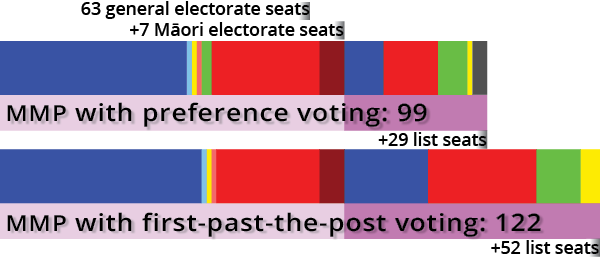Tuned-up mmp could be ninety-nine not out


Less is More: Parliament could be knocked back to 99 seats, and be more representative, was Aotearoa to lead the world by layering preference voting over mixed-member proportional. Note how, in 2008, the undeserving Act Party, yellow, prospered while New Zealand First, grey, was punished, thanks to the dotty coattails provision—which must be scrapped. chart Mahurangi Magazine
First, it was a fateful decision. Then it became a cynical decision, when New Zealand’s parliament ignored the 81.5% of voters who asked for the house to be reduced to 99 seats—the cosy two-party duopoly had no desire to see mixed-member proportional… endure.
In fairness, most will have assumed that a reduction would have involved reducing the number of general electorate seats, below the current 63. This would not have been popular, particularly in the southern sparsely-settled areas, where the electorates are already vast geographically—Clutha–Southland is a daunting 38 247 square kilometres. But there is an alternative to reducing the number of electorates that would be popular: Reduce the number of list seats. Popular wisdom has it that a high number of list seats, 52 in 2008, is required in order that the ratio of party seats closely matches the party vote. This assumes, however, that the mix of electorate candidates will be wildly different from the party vote. And it will be, until preferential voting replaces first-past-the-post to elect electorate members.
Take a typical electorate where Labour and National are well supported, and Green is to at least some extent—given that other parties only feature thanks to the coattails provision, and given recent events, only Green will be used in this exploration. If Labour and National are neck-and-neck, the Green vote will generally give the seat to National, meaning that one Labour list seat is required every second time this happens. Meantime, in a seat where the Green Party is strongly supported, and fields a charismatic candidate, it is likely that Green representation would be more preferable to both Labour and National voters, to being represented, respectively, by either a National or Labour member. The net result of both these scenarios is that fewer list seats are needed to ‘correct’ the electorate result. In the 2008 election, 29 would probably have been needed. Bringing Parliament back to 99 seats; what the people asked for.
As mentioned in Out of All Proportional Aussies Eat Their Greens, the other serious shortcoming in New Zealand’s mixed-member-proportional implementation is that it fails to accurately capture voters’ party preferences, particularly those for minor parties, particularly those for the Green Party.
Sticking with the Green perplexity: Droves of voters who wish to support Green, but also wish to express a preference for a Labour-led government are mistakenly ticking the Green candidate box, and the Labour party box. Unfortunately, few countries that have adopted mixed-member proportional have succeeded in adequately educating voters to understand that only the party vote matters, in determining which party, or parties govern—the exception are electorates subject to the ludicrous coattails provision, which must be scrapped in any event.
The Green Party perpetuates the problem by stubbornly standing candidates in nearly every electorate. As to whether the party or its supporters are more to blame is not a toss-up: The party is the tosser because it has the responsibility to get its head around the problem—voters can’t be expected to remember subtleties of the system from one three-year election event to the next. But this is to shift the primary blame from the designers of the system, who failed to understand that proportionality and preference were both essential attributes of any system that seeks to accurately capture the voter’s intention.
The tune-up needed is trivial: Allow voters to rank their preferred candidate and party. A one, a two and a three, rather than a tick. mmp could be 99 members, not out.
